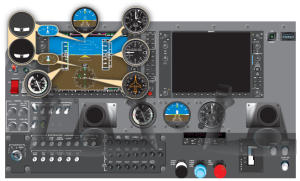The attitude of an aircraft is controlled by movement around its lateral (pitch), longitudinal (roll), and vertical (yaw) axes. In instrument flying, attitude requirements are determined by correctly interpreting the flight instruments. Instruments are grouped as to how they relate to control, function and aircraft performance. Attitude control is discussed in terms of pitch, bank, and power control. The three pitot-static instruments, the three gyroscopic instruments, and the tachometer or manifold pressure gauge are grouped into the following categories:
Pitch Instruments:
• Attitude Indicator
• Altimeter
• Airspeed Indicator
• Vertical Speed Indicator
Bank Instruments:
• Attitude Indicator
• Heading Indicator
• Turn Coordinator
Power Instruments:
• Manifold Pressure Gauge
• Tachometer
• Airspeed Indicator
When climbing and descending, it is necessary to begin level-off in enough time to avoid overshooting the desired altitude. The amount of lead to level-off from a climb varies with the rate of climb and pilot technique. If the aircraft is climbing at 1,000 feet per minute, it will continue to climb at a descending rate throughout the transition to level flight. An effective practice is to lead the altitude by 10% of the vertical speed (500 fpm would have a 50 foot lead; 1,000 fpm would have a 100 foot lead).
The amount of lead to level-off from a descent also depends upon the rate of descent and control technique. To level-off from a descent at descent airspeed, lead the desired altitude by approximately 10%. For level-off at an airspeed higher than descending airspeed, lead the level-off by approximately 25%.
When making initial pitch attitude corrections to maintain altitude during straight-and-level flight, the changes of attitude should be small and smoothly applied. As a rule-of-thumb for airplanes, use a half-bar-width correction for errors of less than 100 feet and a full-bar-width correction for errors in excess of 100 feet.
These are the types of attitude instrument flying questions you can expect to see on an instrument knowledge test. Using the information above you should be able to easily answer each of the three questions.
1. Which instruments, in addition to the attitude indicator, are pitch instruments?
A—Altimeter and airspeed only.
B—Altimeter and VSI only.
C—Altimeter, airspeed indicator, and vertical speed indicator.
2. Which instruments should be used to make a pitch correction when you have deviated from your assigned altitude?
A—Altimeter and VSI.
B—Manifold pressure gauge and VSI.
C—Attitude indicator, altimeter, and VSI.
3. For maintaining level flight at constant thrust, which instrument would be the least appropriate for determining the need for a pitch change?
A—Altimeter.
B—VSI.
C—Attitude indicator.
Answers
↓
↓
↓
↓
The answer to all three questions is C.
For additional sample FAA Knowledge Test questions pick up a copy of the ASA Test Prep or Prepware Software for Instrument Rating.





